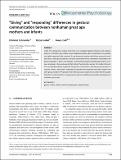"Giving" and "responding" differences in gestural communication between nonhuman great ape mothers and infants
Date
04/2017Metadata
Show full item recordAbstract
In the first comparative analysis of its kind, we investigated gesture behavior and response patterns in 25 captive ape mother-infant dyads (six bonobos, eight chimpanzees, three gorillas, and eight orangutans). We examined i) how frequently mothers and infants gestured to each other and to other group members; and ii) to what extent infants and mothers responded to the gestural attempts of others. Our findings confirmed the hypothesis that bonobo mothers were more proactive in their gesturing to their infants than the other species. Yet mothers (from all four species) often did not respond to the gestures of their infants and other group members. In contrast, infants ‘pervasively’ responded to gestures they received from their mothers and other group members. We propose that infants’ pervasive responsiveness rather than the quality of mother investment and her responsiveness may be crucial to communication development in nonhuman great apes.
Citation
Schneider , C , Liebal , K & Call , J 2017 , ' "Giving" and "responding" differences in gestural communication between nonhuman great ape mothers and infants ' , Developmental Psychobiology , vol. 59 , no. 3 , pp. 303-313 . https://doi.org/10.1002/dev.21495
Publication
Developmental Psychobiology
Status
Peer reviewed
ISSN
0012-1630Type
Journal article
Collections
Items in the St Andrews Research Repository are protected by copyright, with all rights reserved, unless otherwise indicated.

